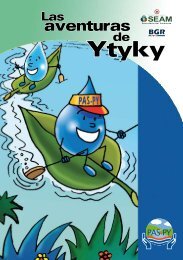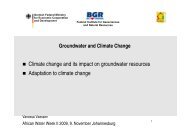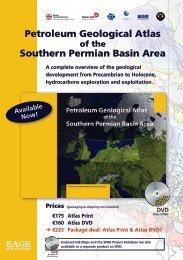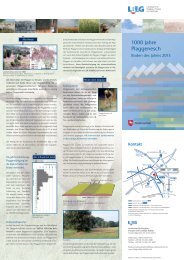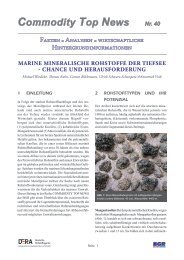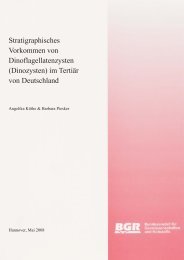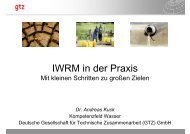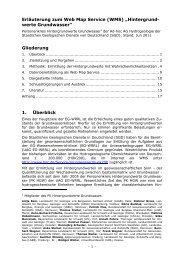Groundwater in the Volta Basin (PDF, 571 KB - BGR
Groundwater in the Volta Basin (PDF, 571 KB - BGR
Groundwater in the Volta Basin (PDF, 571 KB - BGR
Create successful ePaper yourself
Turn your PDF publications into a flip-book with our unique Google optimized e-Paper software.
1.0 Introduction<br />
GROUNDWATER IN THE VOLTA BASIN<br />
The <strong>Volta</strong> is a transboundary river, which is shared by six countries <strong>in</strong> West Africa; Bén<strong>in</strong>, Burk<strong>in</strong>a Faso,<br />
Cote d’Ivoire, Ghana, Mali and Togo. It stretches from north to south over a distance of 1850 km with a<br />
bas<strong>in</strong> cover<strong>in</strong>g an area of approximately 400,000 km 2 (Fig. 1).<br />
The bas<strong>in</strong> area <strong>in</strong> <strong>the</strong> six countries varies. It ranges from 2.48% <strong>in</strong> Cote d’Ivoire to 42.9% <strong>in</strong> Burk<strong>in</strong>a Faso.<br />
On <strong>the</strong> o<strong>the</strong>r hand, while <strong>the</strong> <strong>Volta</strong> bas<strong>in</strong> covers 70.1% of <strong>the</strong> land area of Ghana, it dw<strong>in</strong>dles to 1.0 % <strong>in</strong><br />
Mali.<br />
2.0 Hydrogeology<br />
The geology of <strong>the</strong> ma<strong>in</strong> <strong>Volta</strong> (Fig. 2) is dom<strong>in</strong>ated by <strong>the</strong> <strong>Volta</strong>ian system, which toge<strong>the</strong>r with <strong>the</strong><br />
basement complex dom<strong>in</strong>ate <strong>the</strong> hydrogeological systems (Barry et al., 2006). In Ghana for example, <strong>the</strong><br />
basement complex covers 54 % of <strong>the</strong> land area and contributes 50% of groundwater resources. The<br />
sedimentary formation underlies about 45% of <strong>the</strong> country and provides 39 % of groundwater (Fig. 3).<br />
3.0 Transboundary <strong>Groundwater</strong><br />
At a recent UNESCO Workshop on Inventory of Transboundary Aquifers <strong>in</strong> West Africa, <strong>in</strong> Cotonou,<br />
Ben<strong>in</strong>, from 30 May to 01 June 2007, <strong>the</strong> follow<strong>in</strong>g shared bas<strong>in</strong>s were identified <strong>in</strong> <strong>the</strong> <strong>Volta</strong> bas<strong>in</strong> (Table<br />
1).<br />
Table 1 Transboundary <strong>Groundwater</strong> <strong>in</strong> <strong>the</strong> <strong>Volta</strong> Bas<strong>in</strong><br />
Shared Bas<strong>in</strong> Characteristics Countries<br />
Iullimeden 3 aquifer bas<strong>in</strong>s with River Niger as <strong>the</strong> Mali, Niger, Nigeria Bén<strong>in</strong>,<br />
sou<strong>the</strong>rn limit.<br />
Algeria<br />
Taoudéni Various types of sandstone. The bas<strong>in</strong> is Burk<strong>in</strong>a, Mali, Mauritania,<br />
virtually unknown<br />
Algeria<br />
Tano Coastal sedimentary bas<strong>in</strong> located <strong>in</strong> <strong>the</strong><br />
lower reaches of <strong>the</strong> Tano River <strong>in</strong> Ghana. 3<br />
aquifer horizons with potential to supply<br />
Abidjan. Not much <strong>in</strong>formation available.<br />
Cote d’Ivoire, Ghana<br />
Keta Coastal sedimentary bas<strong>in</strong>, which <strong>in</strong>cludes<br />
<strong>the</strong> <strong>Volta</strong> estuary. 3 transboundary aquifers,<br />
which supply water to key coastal urban<br />
centres <strong>in</strong>clud<strong>in</strong>g Lome, Cotonou, Lagos<br />
and Port Harcout<br />
Ghana, Togo, Bén<strong>in</strong> and Nigeria<br />
<strong>Volta</strong> Information is very scanty. The bas<strong>in</strong> is<br />
virtually unknown.<br />
Burk<strong>in</strong>a, Bén<strong>in</strong>, Togo<br />
Liptako Gourma* Crystall<strong>in</strong>e basement aquifer Burk<strong>in</strong>a Faso, Niger<br />
*Not <strong>in</strong>cluded <strong>in</strong> workshop list but could occur <strong>in</strong> <strong>the</strong> <strong>Volta</strong> bas<strong>in</strong> (Fig. 4)<br />
While some of <strong>the</strong> aquifers were virtually unknown, <strong>in</strong>formation on <strong>the</strong> o<strong>the</strong>rs was scanty. From available<br />
<strong>in</strong>formation, <strong>in</strong>consistencies occur <strong>in</strong> data and <strong>in</strong>formation on groundwater <strong>in</strong> <strong>the</strong> <strong>Volta</strong> bas<strong>in</strong> as a result of<br />
<strong>in</strong>adequate knowledge on <strong>the</strong> resources. For example, <strong>the</strong> aquifers identified dur<strong>in</strong>g <strong>the</strong> above workshop<br />
did not <strong>in</strong>clude <strong>the</strong> Liptako Gourma, which is shared by Burk<strong>in</strong>a Faso and Niger.<br />
In spite of this, it can be <strong>in</strong>ferred that all <strong>the</strong> six riparian countries of <strong>the</strong> <strong>Volta</strong> share, at least, one<br />
groundwater bas<strong>in</strong> with ano<strong>the</strong>r country (Table 2). Ben<strong>in</strong> shares as many as four bas<strong>in</strong>s with <strong>the</strong> o<strong>the</strong>r<br />
riparian countries. Two bas<strong>in</strong>s, <strong>the</strong> Tano and <strong>Volta</strong> are shared solely by <strong>the</strong> riparian countries of <strong>the</strong> <strong>Volta</strong><br />
while four bas<strong>in</strong>s are shared with o<strong>the</strong>r non-riparian countries (Fig. 4).
Table 2 Shared <strong>Groundwater</strong> Bas<strong>in</strong>s<br />
No. of Shared <strong>Groundwater</strong> Bas<strong>in</strong>s<br />
Country<br />
With Riparian Countries With Non-Riparian Countries<br />
Ben<strong>in</strong> 3 2<br />
Burk<strong>in</strong>a Faso 2 2<br />
Cote d’Ivoire 1 -<br />
Ghana 2 1<br />
Mali 2 2<br />
Togo 1 1<br />
4.0 Utilization and Problems<br />
<strong>Groundwater</strong> resources <strong>in</strong> <strong>the</strong> <strong>Volta</strong> bas<strong>in</strong> are used ma<strong>in</strong>ly for domestic water supply <strong>in</strong> both urban and<br />
rural areas. Key cities such as Ouagadougou, Cotonou and Lomé all rely on groundwater for a significant<br />
proportion of <strong>the</strong>ir water supplies. In many rural areas, groundwater is <strong>the</strong> only source of safe portable<br />
water supply. <strong>Groundwater</strong> is also used for water<strong>in</strong>g of livestock and crop irrigation but on a comparatively<br />
limited scale. In general many groundwater sources are untapped although <strong>the</strong> rate of use is rapidly<br />
<strong>in</strong>creas<strong>in</strong>g (ECOWAS-SWAC/OECD, 2006).<br />
The major problems associated with utilization of groundwater <strong>in</strong> <strong>the</strong> <strong>Volta</strong> bas<strong>in</strong> <strong>in</strong>clude:<br />
• Over exploitation as a result of population pressure;<br />
• Contam<strong>in</strong>ation and pollution problems from poor domestic and <strong>in</strong>dustrial waste disposal practices;<br />
• Deforestation and creation of irrigation dams result<strong>in</strong>g <strong>in</strong> reduced aquifer recharge;<br />
• Intrusion of sal<strong>in</strong>e waters and high fluoride and iron concentrations affect<strong>in</strong>g water quality;<br />
• Impacts of reduced ra<strong>in</strong>fall and global climatic change.<br />
5.0 Management of <strong>Groundwater</strong> <strong>in</strong> <strong>the</strong> <strong>Volta</strong> Bas<strong>in</strong><br />
The management of groundwater occurs at different levels <strong>in</strong> <strong>the</strong> various countries. While some countries<br />
<strong>in</strong>clud<strong>in</strong>g Burk<strong>in</strong>a Faso, Cote d’Ivoire and Ben<strong>in</strong> have established systems to monitor shared aquifers,<br />
o<strong>the</strong>rs such as Ghana and Togo do not have such systems <strong>in</strong> place. Monitor<strong>in</strong>g is ma<strong>in</strong>ly by <strong>the</strong> use of<br />
networks of piezometers. However, <strong>in</strong> all cases, <strong>in</strong>stalled monitor<strong>in</strong>g systems are not adequate.<br />
Data and <strong>in</strong>formation are not sufficient to nei<strong>the</strong>r map out <strong>the</strong> aquifers nor assess <strong>the</strong>ir recharge. Also, both<br />
public and private sector <strong>in</strong>stitutions cont<strong>in</strong>ue to operate sectorally, with little coord<strong>in</strong>ation. At <strong>the</strong><br />
transboundary level, <strong>the</strong>re is virtually no contacts or cooperation between <strong>the</strong> various national <strong>in</strong>stitutions<br />
responsible for <strong>the</strong> management of groundwater resources.<br />
Legislation for <strong>the</strong> management of groundwater resources is not common. It usually forms part of general<br />
codes for protection of water resources or <strong>the</strong> environment and is not specific to ground water. However,<br />
efforts are be<strong>in</strong>g made to improve <strong>the</strong> situation as <strong>in</strong> Ghana, which has recently passed ‘Drill<strong>in</strong>g License<br />
and <strong>Groundwater</strong> Development Regulations’ <strong>in</strong> attempt to control drill<strong>in</strong>g and improve data collection.<br />
6.0 Way Forward<br />
Many recommendations exist for improved management of groundwater resources <strong>in</strong> West Africa of which<br />
<strong>the</strong> <strong>Volta</strong> bas<strong>in</strong> is a part. These <strong>in</strong>clude <strong>the</strong> follow<strong>in</strong>g:<br />
Tripoli June 2002 UNESCO/ISARM Workshop on Manag<strong>in</strong>g Shared Aquifers Resources <strong>in</strong> Africa, which<br />
highlighted <strong>the</strong> need to:<br />
• Conduct <strong>in</strong>ventories of African shared aquifers;<br />
• Prepare guidel<strong>in</strong>es for sound and susta<strong>in</strong>able development of shared aquifers;<br />
• Initiate activities with <strong>the</strong> support of partners with<strong>in</strong> <strong>the</strong> framework of ISARM Africa;<br />
2
• Include <strong>the</strong> NEPAD and AMCOW process<br />
<strong>Groundwater</strong> Capacity Build<strong>in</strong>g Initiative <strong>in</strong> Africa (<strong>BGR</strong>/Cap-Net/WA-Net/Waternet), whose survey<br />
resulted <strong>in</strong> key recommendations for improvement <strong>in</strong> groundwater management as follows:<br />
• <strong>Groundwater</strong> assessment and development;<br />
• Institutional and legal arrangements;<br />
• <strong>Groundwater</strong> protection;<br />
• <strong>Groundwater</strong> education and tra<strong>in</strong><strong>in</strong>g<br />
Cotonou June 2007 UNESCO/ISARM Workshop on Inventory of Transboundary Aquifers <strong>in</strong> West Africa,<br />
which made recommendations to:<br />
• Prepare an atlas of shared aquifers <strong>in</strong> West Africa;<br />
• Conduct case studies for selected aquifer bas<strong>in</strong>s;<br />
• Increase participation of decision makers <strong>in</strong> management of shared bas<strong>in</strong>s<br />
All <strong>the</strong> above recommendations are still valid and relevant and <strong>the</strong> <strong>Volta</strong> Bas<strong>in</strong> Authority supports <strong>the</strong>m as<br />
provid<strong>in</strong>g <strong>the</strong> right direction for improv<strong>in</strong>g management of shared groundwater resources. The VBA<br />
<strong>the</strong>refore wishes to participate fully <strong>in</strong> <strong>the</strong>se activities. Although VBA, just as o<strong>the</strong>r bas<strong>in</strong> organizations <strong>in</strong><br />
West Africa, is named on <strong>the</strong> basis of <strong>the</strong> more obvious <strong>Volta</strong> River, its Statutes <strong>in</strong>directly take <strong>in</strong>to<br />
consideration <strong>the</strong> management of groundwater resources, with references to ‘development of natural<br />
resources’ and ‘adoption of <strong>in</strong>tegrated water resources management’.<br />
At this stage, due to <strong>the</strong> need to m<strong>in</strong>imize duplication and conserve resources, it is not necessary to create<br />
new <strong>in</strong>stitutions with<strong>in</strong> <strong>the</strong> <strong>Volta</strong> bas<strong>in</strong> or <strong>in</strong> West Africa specifically for management of groundwater<br />
resources. Also, s<strong>in</strong>ce all water resources should be managed toge<strong>the</strong>r, VBA and o<strong>the</strong>r exist<strong>in</strong>g bas<strong>in</strong><br />
organizations as well as <strong>in</strong>stitutions such as ECOWAS Water Resources Coord<strong>in</strong>ation Unit should be<br />
streng<strong>the</strong>ned to <strong>in</strong>tegrate management of groundwater resources <strong>in</strong>to <strong>the</strong>ir scope of activities. This can be<br />
achieved through <strong>the</strong> modification or expansion of activities such as <strong>the</strong> operation of observatories and<br />
implementation of <strong>the</strong> HYCOS projects. The Statutes or o<strong>the</strong>r relevant <strong>in</strong>ternational agreements of <strong>the</strong><br />
bas<strong>in</strong> organizations can also be modified to specifically <strong>in</strong>clude groundwater.<br />
While it is urgent to improve <strong>the</strong> management of groundwater resources <strong>in</strong> <strong>the</strong> area of <strong>the</strong> <strong>Volta</strong> bas<strong>in</strong>, with<br />
particular emphasis on shared aquifer bas<strong>in</strong>s, repeat<strong>in</strong>g <strong>the</strong> mistake of management of water resources on a<br />
sectoral basis should be avoided, even though it appears to be an easier option.<br />
In addition to <strong>the</strong> required cooperation among <strong>the</strong> riparian countries of <strong>the</strong> <strong>Volta</strong> bas<strong>in</strong>, is is important to<br />
streng<strong>the</strong>n <strong>in</strong>ter-bas<strong>in</strong> cooperation s<strong>in</strong>ce majority of <strong>the</strong> riparian countries share aquifer bas<strong>in</strong>s with some<br />
non-<strong>Volta</strong> countries. Also, <strong>in</strong> view of <strong>the</strong> grow<strong>in</strong>g importance of groundwater to <strong>the</strong> improvement of<br />
livelihoods <strong>in</strong> <strong>the</strong> <strong>Volta</strong> bas<strong>in</strong>, more reliable data and <strong>in</strong>formation should be generated to support<br />
susta<strong>in</strong>able management of <strong>the</strong> resources. The VBA <strong>the</strong>refore wishes to solicit <strong>the</strong> support of its<br />
<strong>in</strong>ternational technical and f<strong>in</strong>ancial partners to undertake a case study of <strong>the</strong> transboundary aquifers of <strong>the</strong><br />
<strong>Volta</strong> bas<strong>in</strong>.<br />
8.0 REFERENCES<br />
Barry, B. Obuobie, E., Andre<strong>in</strong>i, M., Andah, W. and Pluquet, M., 2006. The <strong>Volta</strong> River Bas<strong>in</strong> ;<br />
Comparative study of river bas<strong>in</strong> development and management. IWMI, Comprehensive Assessment of<br />
Water Management <strong>in</strong> Agriculture<br />
ECOWAS-SWAC/OECD. 2006. http:www.atlas-ouestafrique.org/spip.php?article 133.<br />
<strong>Volta</strong> HYCOS, 2003. Project Document<br />
3
Fig. 1 Map of <strong>the</strong> <strong>Volta</strong> Bas<strong>in</strong> and Riparian Countries (<strong>Volta</strong> HYCOS, 2003)<br />
Fig.2 Geological Map of <strong>the</strong> <strong>Volta</strong> Bas<strong>in</strong> (Barry et al., 2006)<br />
4
Fig. 3 Hydrogeological Prov<strong>in</strong>ces and River Systems of Ghana (Geological Survey of Ghana 1969)<br />
Source: ISARM Africa<br />
3. Taoudéni<br />
4. Iullimeden<br />
12. Liptako Gourma<br />
13. Tano<br />
14. Keta<br />
The <strong>Volta</strong> aquifer is not represented<br />
Fig. 4 Shared Aquifer Bas<strong>in</strong>s <strong>in</strong> <strong>the</strong> <strong>Volta</strong> Bas<strong>in</strong><br />
5


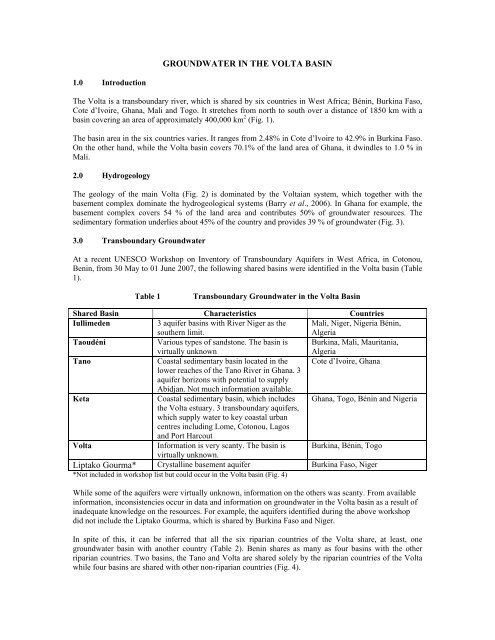


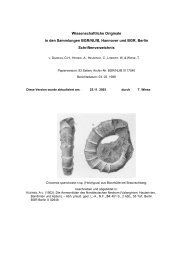
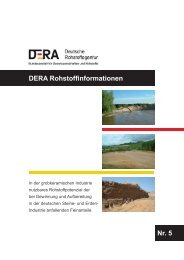
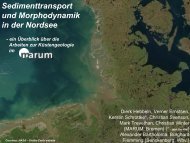
![Tröpfis weltweite Abenteuer [deutsch] (PDF, 6 MB) - BGR - Bund.de](https://img.yumpu.com/13203261/1/184x260/tropfis-weltweite-abenteuer-deutsch-pdf-6-mb-bgr-bundde.jpg?quality=85)
